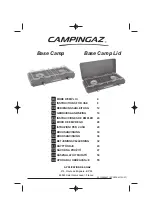
24
4.
To clean deposits from the boiler baffles set to
position B and clean both sides down in to
firebox. Remove all soot deposits from the
boiler, and the firebox baffles, and generally
clean out the firebox area. N.B.: Do not use a
scraper on the ceramic baffles. Check condition
of baffles and oven protection plate and replace
if necessary.
It is helpful to use a vacuum cleaner to collect
dust deposits that will have accumulated.
5.
Care should be taken when refitting the burner
assembly that the insulation material over the
burner blast tube is not damaged. Also ensure
that the electrical and oil leads are not twisted.
Push the burner assembly into position and
ensure a good seal. Tighten screws, replace air
grill and cover plate, etc.
6.
Replace the oven passage way cleaning plate,
simmer cleaning plate and bend cleaning plate,
ensuring that the surfaces have been cleaned
and that fresh fire cement or gasket has been
used. Use new insulating tape before replacing
the hotplate, clean off cement from hotplate
cleaning panel and apply fresh cement or
gasket. Tighten home fully the retaining screw in
the cleaning panel connected to the tie bar.
7.
Switch on electrical and oil supply. The cooker is
now ready for operation.
8.
Undertake combustion test, flue draught and
check for spillage.
CLEANING
IMPORTANT: BE CAREFUL OF THE HOT
APPLIANCE.
General cleaning must be carried out when the
cooker is cool.
Stanley cookers are finished in a high gloss vitreous
enamel. To keep the enamel in the best condition
observe the following tips:
1.
Wipe over daily with a soapy damp cloth,
followed by a polish with a clean dry duster.
2.
If milk, fruit juice or anything containing acid is
spilt on the hob or down the cooker, be sure to
wipe it immediately or the vitreous enamel may
be
permanently
discoloured.
Jam
and
preservatives containing sugar can permanently
damage the vitreous enamel.
3.
Keep a damp cloth to hand while cooking, to
wipe up any spills as they occur, so they do not
harden and become more difficult to remove
later.
4.
If spills do become baked on, a cream cleanser
can be used. For stubborn deposits a soap
impregnated pad can be carefully used on the
vitreous enamel.
5.
Use only products recommended by the
Vitreous Enamel Association, these products
carry the Vitramel label.
6.
In the oven, spills and fat splashes are
carbonised at high temperatures: occasionally
brush out with a stiff brush. The shelves can be
soaked and cleaned with a cream cleanser.
7.
Both insulating covers should be raised and
allowed to cool before cleaning the enamel with
a soapy damp cloth. Use a wire brush to keep
the cast iron hotplate clean.
DO NOT USE ABRASIVE PADS OR OVEN
CLEANERS CONTAINING CITRIC ACID ON
ENAMELLED SURFACES. ENSURE THAT THE
CLEANSER MANUFACTURERS INSTRUCTIONS
ARE ADHERED TO.
MILD STEEL
The steel side panels and splash back must not be
cleaned with steel wool. Use only washing up
liquid in hot water with a lint free cloth. Dry off and
apply a coat of good quality furniture polish.
OVENS
Grease spillages will burn off from the oven interior,
when the oven is hot and any other loose materials
can be wiped out with a cloth when cold. Stubborn
stains in the oven and on the shelves in the oven
can be cleaned off with a paste of bread soda and
water.
HOT PLATE
The hotplate may be cleaned using a small amount
of paraffin oil or fine steel wool to remove rust or
cooking stains. Dry off with a lint free cloth and
apply a light coat of cooking oil to preserve the
finish.
WARNING: THIS APPLIANCE MUST NOT BE
INCORRECTLY USED.
IMPORTANT: WE DO NOT RECOMMEND DEEP
FAT FRYING ON THIS APPLIANCE.
ASSOCIATION



































